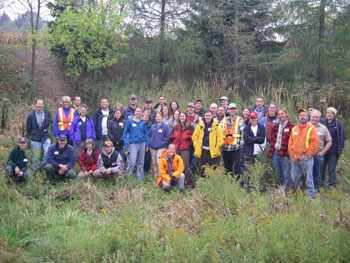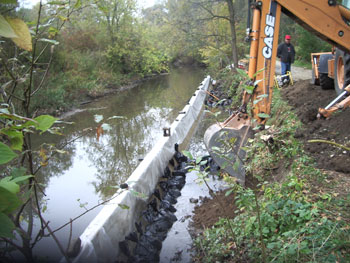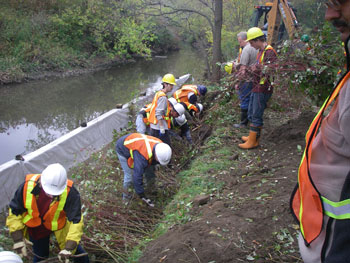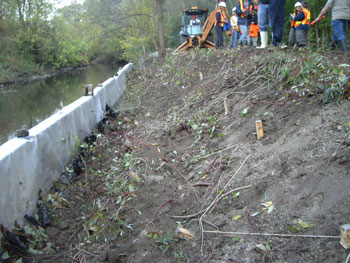Introductory Bioengineering Course
The 2007 Introduction to Bioengineering Course took place October 16th and 17th in St. Clements, Ontario. This course was very well attended with diverse participant affiliation ranging from federal and provincial agencies, various conservation authorities and consulting firms, non-government organizations, as well as individual entrepreneurs and interested parties.
The community support was equally impressive with Glenn Harrington, of Harrington and Hoyle Ltd. leading the charge. Glenn’s experience and grasp of industry challenges, attitudes and techniques were well blended into a montage of basic techniques and examples that bode well to demonstrate what can be done with a little ingenuity, willingness and openness to alternatives that counter the idea of “hard” engineering.
Providing extensive examples, Glenn presented several scenarios demonstrating various soil bioengineering techniques (live fascines, brush layering, brush mattresses & staking) and their temporal effectiveness by way of before, after, and long-term photos of completed projects.
Bob Morris of Credit Valley Conservation presented the challenges associated with garnering community support and working with private land owners, volunteers and community groups. Harry Reinders of R&M Construction delivered a well-rounded end to the presentations by providing a contractors perspective of construction and implementation. Harry has been actively involved in restoration projects for over 15 years and demonstrated the real world of engineering, construction, timelines, scheduling and the reality of pulling it all together.
Day 1 ended with a “field trip” to cut, gather and prepare our brush material for the next day’s hands-on project. Day 2 began with morning field trips to three bioengineered project sites, all of which were completed by Harrington and Hoyle more than 10 years ago. This tour entailed a description of the challenges, successes and failures often encountered during the planning and field phases of such projects.
The “course practical” wrapped up this two-day extravaganza by engaging all participants in the actual reconstruction of a 20-m section of Laurel Creek in Hillside Park, Waterloo. It was terrific to feel the genuine enthusiasm and camaraderie of the group as we all tried our hand at building and installing fascines, brush layers and brush mattresses, while live staking our construction to ensure our efforts did not wash away in the next storm event.
The success of this entire project could not have taken place so easily without the generous contributions and involvement of the City of Waterloo. We extend our deepest thanks and gratitude to Denise McGoldrick, Len Fay, Dan Ditaranto and ground crews of the City of Waterloo for helping to organize and prepare the test site by isolating the work area with jersey barriers and sand bags, collecting and delivering our brush cuttings and extra compaction soil and for providing a backhoe and operator extraordinaire to play with us. Kudos to Samantha Mason of the Grand River Conservation Authority for organizing a VERY successful and informative Introductory Bioengineering Course.




